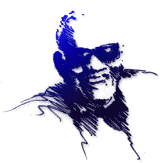RAY
CHARLES

Many
musicians possess elements of genius, but only one -- the great Ray Charles
-- so completely
embodies
the term that it's been bestowed upon him as a nickname. Charles displayed
his genius by
combining
elements of gospel and blues into a fervid, exuberant style that would
come to be known as
soul
music. While recording for Atlantic Records during the Fifties, the innovative
singer, pianist and
bandleader
broke down the barriers between sacred and secular music. The gospel sound
he'd heard
growing
up in the church found its way into the music he made as an adult. In his
own words, he fostered
"a
crossover between gospel music and the rhythm patterns of the blues." But
he didn't stop there: over
the
decades, elements of country & western and big-band jazz have infused
his music as well. He is as
complete
and well-rounded a musical talent as this century has produced.
Born
in Albany, Georgia, on September 23, 1930, Charles was raised in Greenville,
Florida, where he
made
the acquaintance of a piano-playing neighbor. As a youngster, Charles apprenticed
with him at his
small
store-cum-juke joint while digesting the blues, boogie-woogie and big-band
swing records on his
jukebox.
At age six, he contracted glaucoma, which eventually left him blind. Charles
studied
composition
and mastered a variety of instruments, piano and saxophone principal among
them, during
nine
years spent at the St. Augustine School for the Deaf and the Blind. Thereafter,
he played around
Florida
in a variety of bands and then headed for the West Coast, where he led
a jazz-blues trio that
performed
in the polished style of Nat "King" Cole and Charles Brown. After cutting
singles for labels
such
as Downbeat and Swingtime, Charles wound up on Atlantic Records in 1952.
It turned out to be
an
ideal match between artist and label, as both were just beginning to find
their feet.
Given
artistic control at Atlantic after demonstrating his knack as an arranger
with Guitar Slim's "Things
That
I Used to Do" -- the biggest R&B hit of 1954 -- Charles responded with
a string of recordings in
which
he truly found his voice. This extended hit streak, which carried him through
the end of the
decade,
included such unbridled R&B milestones as "I Got a Woman," "Hallelujah
I Love Her So,"
"Drown
in My Own Tears" and the feverish call-and-response classic "What'd I Say."
All were sung in
Charles'
gruff, soulful voice and accompanied by the percussive punctuations of
his piano and a horn
section.
After his groundbreaking Atlantic years, Charles moved to ABC/Paramount,
where he claimed
the
unlikeliest of genres as his own with Modern Sounds in Country and Western
Music, an album that
topped
the Billboard chart for 14 weeks in 1962. He has remained active as a performer
and recording
artist
through to the present day, still pursuing that uncategorizable blend of
idioms that is best described
with
a single word: soul.
And
just what is soul, according to Ray Charles? As he told Time magazine in
1968, "It's a force that
can
light a room. The force radiates from a sense of selfhood, a sense of knowing
where you've been
and
what it means. Soul is a way of life -- but it's always the hard way."
Ray Charles Lyrics


